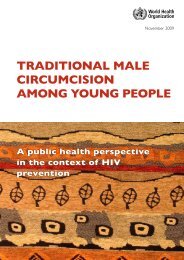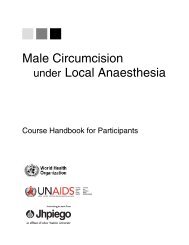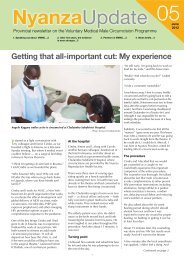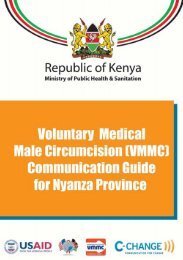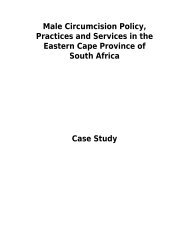Manual for Male Circumcision under Local Anaesthesia
Manual for Male Circumcision under Local Anaesthesia
Manual for Male Circumcision under Local Anaesthesia
Create successful ePaper yourself
Turn your PDF publications into a flip-book with our unique Google optimized e-Paper software.
<strong>Male</strong> circumcision <strong>under</strong> local anaesthesia Version 2.5C (Jan08)<br />
Randomized controlled trials to assess the efficacy of male<br />
circumcision in reducing risk of HIV infection<br />
• In July 2005 the results of the Orange Farm Intervention Trial in<br />
South Africa were made public; they were subsequently published<br />
in November 2005. 6 This was the first report from a randomized<br />
controlled trial of male circumcision as a means to prevent HIV<br />
infection. A total of 3274 uninfected men, aged 18–24 years, were<br />
randomly assigned to <strong>under</strong>go circumcision either immediately or<br />
after 21 months. The incidence of HIV infection was found to be<br />
60% lower among those who were circumcised. On the strength of<br />
these results, the Independent Data Monitoring Committee<br />
recommended that the men initially assigned to the delayed<br />
circumcision group should be offered the procedure without further<br />
delay, without waiting the full 21 months.<br />
• Two further trials on male circumcision and HIV infection were<br />
stopped in December 2006 and published in early 2007. Both trials<br />
involved random allocation of HIV-negative volunteers to either<br />
immediate circumcision, per<strong>for</strong>med by trained medical<br />
professionals in a clinic setting (intervention group), or<br />
circumcision delayed <strong>for</strong> 2 years (control group). The first trial, in<br />
Kisumu, western Kenya, was conducted among men aged 18–24<br />
years, and showed a 53% reduction in HIV incidence. 7 The second<br />
study was conducted in Rakai, Uganda, among men aged 15–49<br />
years, and showed a 51% reduction in HIV incidence. 8 Following<br />
release of the study results, circumcision was offered without<br />
further delay to the men in both non-intervention groups.<br />
• A further trial in Rakai is focusing on differences in transmission<br />
from circumcised and non-circumcised men to their female<br />
partners. Results are not expected be<strong>for</strong>e late 2008.<br />
Possible biological explanations <strong>for</strong> the protective effect of male<br />
circumcision<br />
• The primary target cells through which HIV enters the body are<br />
Langerhans cells. These cells are present in high density in the<br />
epithelium of the inner <strong>for</strong>eskin, and are close to the surface<br />
because the layer of keratin is thin.<br />
<strong>Male</strong> circumcision and HIV infection Chapter 1-5<br />
18, 19<br />
• In an in vitro study, viral uptake by cells from the mucosal surface<br />
of <strong>for</strong>eskin was 7 times more efficient than that by tissue from the<br />
female cervix. 20 The inner mucosal surface of the <strong>for</strong>eskin lacks<br />
the thick layer of keratin that covers most exposed skin. This<br />
leaves numerous mucosal Langerhans cells and other immune cell<br />
targets easily accessible to HIV infection. 21<br />
• The highly vascularized <strong>for</strong>eskin mucosa, and in particular the<br />
frenulum, is prone to tearing and bleeding during intercourse,<br />
especially with “dry sex”, as practised in some parts of southern<br />
Africa. These micro-injuries allow easy access of HIV to the<br />
bloodstream.<br />
• A further factor facilitating the entry of the virus is the presence of<br />
an ulcerative STI, such as herpes simplex, chancroid or syphilis,<br />
which tend to be more common in uncircumcised men. 5<br />
<strong>Male</strong> circumcision <strong>under</strong> local anaesthesia Version 2.5C (Jan08)<br />
Protection <strong>for</strong> women<br />
• A study in Uganda observed lower rates of male-to-female<br />
transmission of HIV if the man was circumcised. 13 Among 47<br />
couples in which the circumcised male partner was infected with<br />
HIV and whose viral load was below 50 000 copies per ml, none of<br />
the female partners became infected in two years. By contrast, 26<br />
of the 147 women whose HIV-infected partners were not<br />
circumcised became infected.<br />
Other health benefits of circumcision<br />
• A multicountry study 22 found a lower prevalence of human<br />
papillomavirus (HPV) infection in circumcised men than in<br />
uncircumcised men. HPV infection is a necessary causal factor <strong>for</strong><br />
cervical cancer and is associated with an increased risk of cancer<br />
of the vulva, vagina and anus in women, and of the penis and<br />
anus in men.<br />
• The incidence of invasive penile cancer is significantly lower in<br />
circumcised men than in uncircumcised men, though this condition<br />
23, 24<br />
is extremely rare.<br />
Acceptability of circumcision among African men<br />
• Surveys and qualitative studies among young as well as older men<br />
in six African countries have found that a considerable proportion<br />
expressed interest in circumcision, ranging from 45% in Harare,<br />
Zimbabwe, to over 80% in a large survey in Botswana. 25 These<br />
studies indicate that many men would willingly <strong>under</strong>go<br />
circumcision if it could be per<strong>for</strong>med safely and cheaply.<br />
• In the surveys, the men reported that their main interest in<br />
circumcision was related to hygiene, infection control and, <strong>for</strong><br />
some, a belief that condom use is easier <strong>for</strong> men who are<br />
circumcised.<br />
<strong>Male</strong> circumcision and HIV infection Chapter 1-6





